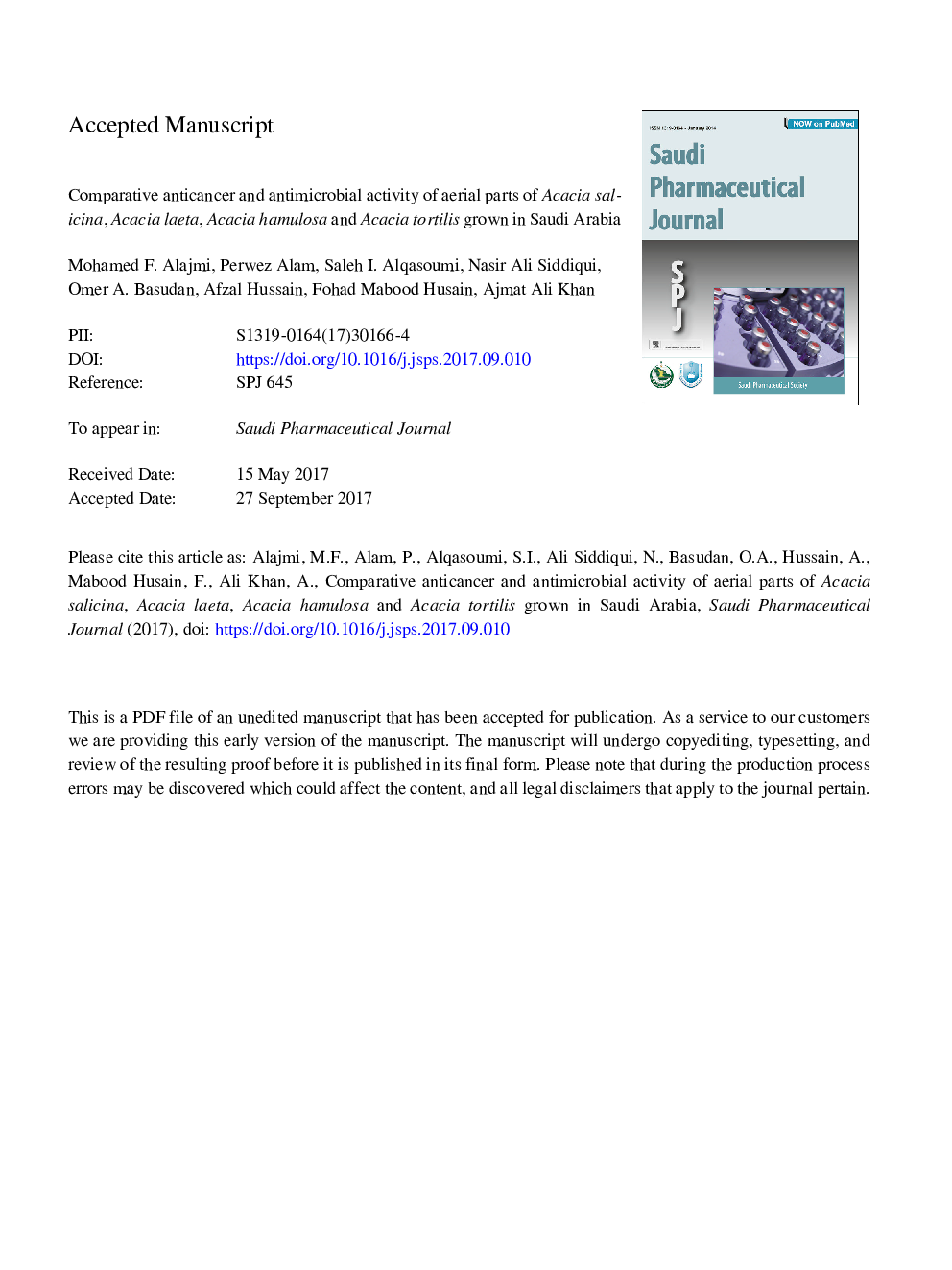| کد مقاله | کد نشریه | سال انتشار | مقاله انگلیسی | نسخه تمام متن |
|---|---|---|---|---|
| 8522745 | 1557756 | 2017 | 22 صفحه PDF | دانلود رایگان |
عنوان انگلیسی مقاله ISI
Comparative anticancer and antimicrobial activity of aerial parts of Acacia salicina, Acacia laeta, Acacia hamulosa and Acacia tortilis grown in Saudi Arabia
دانلود مقاله + سفارش ترجمه
دانلود مقاله ISI انگلیسی
رایگان برای ایرانیان
کلمات کلیدی
موضوعات مرتبط
علوم پزشکی و سلامت
داروسازی، سم شناسی و علوم دارویی
علوم دارویی
پیش نمایش صفحه اول مقاله

چکیده انگلیسی
The standardized ethanol extract (EE) of aerial parts of four Acacia species [A. salicina (ASEE), A. laeta (ALEE), A. hamulosa (AHEE), and A. tortilis (ATEE)] were examined in order to compare their cytotoxic and antimicrobial activities. All the extracts were standardized by UPLC- PDA method using rutin as standard compound. The extracts ALEE, AHEE and ATEE were found to contain rutin along with several other phytoconstituents while rutin was absent in ASEE. All the extracts showed varying level of antimicrobial activity with zone of inhibition ranged from 11 to 21 mm against Staphylococcus aureus, Escherichia coli, Pseudomonas aeruginosa and Candida albicans. The ALEE and ATEE showed relatively high antimicrobial potency (MIC = 0.2 to 1.6 mg mLâ1) in comparison to other extracts. All the extracts were found to reduce the biofilm of P. aeruginosa PAO1 strain significantly in comparison to the untreated control. The cytotoxic property of ASEE, ALEE, AHEE, ATEE were evaluated against HepG2 (Liver), HEK-293 (Kidney), MCF-7 (Breast) and MDA-MB 231 (Breast) cancer cells. Of these, ALEE, AHEE and ATEE exhibited moderate cytotoxic property against human liver carcinoma cells (HepG2; IC50 = 46.2, 39.2 and 42.3 μg mLâ1, respectively) and breast cancer cell lines (MCF-7; IC50 = 57.2, 55.3 and 65.7 μg mLâ1, respectively). The ATEE and ALEE showed moderate cytotoxicity against HEK-293 (kidney) cells with IC50 = 49.1 and 53.5 μg mLâ1, respectively. Since, Acacia species (A. laeta and A. hamulosa) contains numerous polyphenols which might prove to be highly cytotoxic and antimicrobial agents, we suggest that these species can be further subjected to the isolation of more cytotoxic and antimicrobial compounds.
ناشر
Database: Elsevier - ScienceDirect (ساینس دایرکت)
Journal: Saudi Pharmaceutical Journal - Volume 25, Issue 8, December 2017, Pages 1248-1252
Journal: Saudi Pharmaceutical Journal - Volume 25, Issue 8, December 2017, Pages 1248-1252
نویسندگان
Mohamed F. Alajmi, Perwez Alam, Saleh I. Alqasoumi, Nasir Ali Siddiqui, Omer A. Basudan, Afzal Hussain, Fohad Mabood Husain, Azmat Ali Khan,